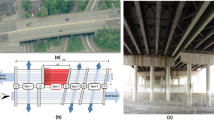Abstract
The objective of the long-term bridge performance (LTBP) program is to collect, document, and make available high quality quantitative performance data for a representative sample of bridges nationwide. As such, the LTBP program will collect data, perform analyses, develop models, and enhance education and practices aimed at extending bridge service life. Data will be collected through live-load and dynamic testing, physical material testing, detailed inspections, NDT/NDE, and long-term structural health monitoring. As part of the pilot phase of the overall program, seven bridges across the United States have been tested and are in various stages of being instrumented for long-term structural health monitoring. This paper focuses on a two-span, post-tensioned, box girder bridge located near Sacramento, California, which is one of the initial pilot bridges. The initial live-load and dynamic testing, physical material testing, detailed visual inspection, and an NDE deck scan have already been performed to establish the baseline bridge condition for future comparisons. Long-term instrumentation including strain gauges, velocity transducers, tiltmeters, vibrating wire strain gauges, thermocouples, and a real time camera have been installed. Once long-term bridge behavior is understood, maintenance decision tools can be developed that will aid bridge owners and administrators in better practice management. This paper describes the initial testing, baseline evaluation, and the long-term monitoring program that was developed.











Similar content being viewed by others
References
Bolton R, Sikorsky C, Park S, Choi S, Stubbs N (2005) Modal property changes of a seismically damaged concrete bridge. J Bridge Eng 10(4):415–428
Eberhard MO, Marsh ML (1997) Lateral-load response of a reinforced concrete bridge. J Struct Eng 123(4):451–460
Proulx J, Herbert D, Paultre P (1992) Evaluation of the dynamic properties of a steel arch bridge. In: Proceedings of 10th International Modal Analysis Conference, Society. For Exper Mech Bethel Conn, 160–165
Halling MW, Muhammad I, Womack KC (2001) Dynamic field testing for condition assessment of bridge bents. J Struct Eng 127(2):161–167
Salawu OS, Williams C (1995) Bridge assessment using forced-vibration testing. J Struct Eng 121(2):161–173
Salawu OS (1997) Assessment of bridges: use of dynamic testing. Can J Civ Eng 24:218–228
Bernal D, Gunes B (2004) Flexibility based approach for damage characterization: benchmark application. J Eng Mech 130(1):61–70
Lam HF, Katafygiotis LS, Mickleborough NC (2004) Application of a statistical model updating approach on phase I of the IASC-ASCE structural health monitoring benchmark study. J Eng Mech 130(1):34–48
Lus H, Betti R, Yu J, De Angelis M (2004) Investigation of a system identification methodology in the context of the ASCE benchmark problem. J Eng Mech 130(2):71–84
Yuen KV, Au SK, Beck JL (2004) Two-stage structural health monitoring approach for phase I benchmark studies. J Eng Mech 130(1):16–33
Lau DT, Cheung MS, Li WC (2000) Dynamic monitoring of the confederation bridge. 12th World conference on earthquake engineering
Ko JM, Ni YQ (2005) Technology developments in structural health monitoring of large-scale bridges. Eng Struct 27:1715–1725
Gillespie TD, Karamihas SM, Sayes MW, Nasim MA, Hansen W, Ehsan N, and Cebon D. (1993) Effects of heavy-vehicle characteristics on pavement response and performance. NCHRP Report #353, Transportation Research Board, Washington, DC 1993
Barr PJ, Stanton JF, Eberhard MO (2005) Effects of temperature variations on precast, prestressed concrete bridge girders. J Bridge Eng 10(2):186–194
Tennyson R, Mufti A, Tadros G, Benmokrane B (2001) Structural health monitoring of innovative bridge in Canada with fiber optic sensors. Smart Mat Struct 10:560–573
Olund J, DeWolf J (2007) Passive structural health monitoring of Connecticut’s bridge infrastructure. J Infrastruct Syst 13(4):330–339
Acknowledgments
This publication was supported by a subcontract from Rutgers University, Center for Advanced Infrastructure & Transportation (CAIT), under DTFH61-08-C-00005 from the US Department of Transportation-Federal Highway Administration (USDOT-FHWA). Any opinions, findings, and conclusions or recommendations expressed in this publication are those of the author(s) and do not necessarily reflect the views of Rutgers University or the US Department of Transportation-Federal Highway Administration.
Author information
Authors and Affiliations
Corresponding author
Rights and permissions
About this article
Cite this article
Barr, P.J., Petroff, S.M., Hodson, D.J. et al. Baseline testing and long-term monitoring of the Lambert Road Bridge for the long-term bridge performance program. J Civil Struct Health Monit 2, 123–135 (2012). https://doi.org/10.1007/s13349-012-0023-2
Received:
Accepted:
Published:
Issue Date:
DOI: https://doi.org/10.1007/s13349-012-0023-2




